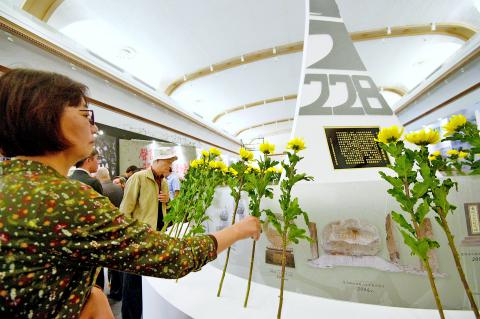An exhibition commemorating pro-democracy movements in Taiwan following the 228 Incident opened in the National 228 Memorial Museum yesterday, with campaigners calling for holding those responsible for the massacre to account and disclosing documents related to the Incident to achieve transitional justice.
The exhibition also commemorates the 30th anniversary of the nation’s first campaign to achieve transitional justice, launched in 1987 by late democracy pioneer Deng Nan-jung (鄭南榕) asking the then-Chinese Nationalist Party (KMT) government to apologize for the massacre and pay compensation to victims, as well as reveal the facts about the Incident and make Feb. 28 a national holiday to commemorate the massacre.
The exhibition features a reconstruction of Deng’s office, a replica of the nation’s first monument dedicated to the Incident, banners and props used by pro-democracy activists, books banned by the former KMT regime, and poems and art inspired by the Incident.

Photo: Chang Chia-ming, Taipei Times
The Incident refers to the crackdown launched by the then-KMT regime against civilian demonstrations following an incident in Taipei on Feb. 27, 1947. The event also marked the beginning of the White Terror era, which saw thousands of Taiwanese arrested, imprisoned and executed.
Deng’s wife, Yeh Chu-lan (葉菊蘭), said the KMT regime killed almost all of the Taiwanese elite during the Incident and the persecutions that followed, an atrocity that silenced Taiwanese for 40 years with people being afraid to talk about the massacre and politics.
Preceded by the “519 Green Movement” in 1986, also initiated by Deng to seek the lifting of martial law, the 228 campaign relieved Taiwanese from the fear of recounting the history of the Incident and motivated them to seek justice, she said.
Although redresses have been made to victims of the Incident, people responsible for the massacre have not been held to account and there might be victims still unnamed in the government’s list, Yeh said.
“Documents written by Chiang Kai-shek (蔣介石) showed that he authorized the executions [of victims of the 228 Incident], but has Chiang been punished by history?” Yeh asked. “There is no transitional justice without perpetrators being punished and the truth being revealed.”
The government needs to disclose all data concerning the massacre and political persecutions to right the wrongs, she added.
While the Democratic Progressive Party (DPP) was established in 1986, few members were involved in Deng’s campaigns, Yeh said, adding that pro-democracy movements at the time were mostly led by regular people, who had to face police violence and persecution.
“The exhibition does not commemorate my late husband, but those people,” she added.
Yeh said she is confident in President Tsai Ing-wen’s (蔡英文) plan to finalize a report on the Incident in three years, although a draft transitional justice bill waits to pass the Legislative Yuan.

SHIPS, TRAINS AND AUTOMOBILES: The ministry has announced changes to varied transportation industries taking effect soon, with a number of effects for passengers Beginning next month, the post office is canceling signature upon delivery and written inquiry services for international registered small packets in accordance with the new policy of the Universal Postal Union, the Ministry of Transportation and Communications said yesterday. The new policy does not apply to packets that are to be delivered to China, the ministry said. Senders of international registered small packets would receive a NT$10 rebate on postage if the packets are sent from Jan. 1 to March 31, it added. The ministry said that three other policies are also scheduled to take effect next month. International cruise ship operators

NUMBERS IMBALANCE: More than 4 million Taiwanese have visited China this year, while only about half a million Chinese have visited here Beijing has yet to respond to Taiwan’s requests for negotiation over matters related to the recovery of cross-strait tourism, the Tourism Administration said yesterday. Taiwan’s tourism authority issued the statement after Chinese-language daily the China Times reported yesterday that the government’s policy of banning group tours to China does not stop Taiwanese from visiting the country. As of October, more than 4.2 million had traveled to China this year, exceeding last year. Beijing estimated the number of Taiwanese tourists in China could reach 4.5 million this year. By contrast, only 500,000 Chinese tourists are expected in Taiwan, the report said. The report

The Forestry and Nature Conservation Agency yesterday launched a gift box to market honey “certified by a Formosan black bear” in appreciation of a beekeeper’s amicable interaction with a honey-thieving bear. Beekeeper Chih Ming-chen (池明鎮) in January inspected his bee farm in Hualien County’s Jhuosi Township (卓溪) and found that more than 20 beehives had been destroyed and many hives were eaten, with bear droppings and paw prints near the destroyed hives, the agency said. Chih returned to the farm to move the remaining beehives away that evening when he encountered a Formosan black bear only 20m away, the agency said. The bear

HORROR STORIES: One victim recounted not realizing they had been stabbed and seeing people bleeding, while another recalled breaking down in tears after fleeing A man on Friday died after he tried to fight the knife-wielding suspect who went on a stabbing spree near two of Taipei’s busiest metro stations, Taipei Mayor Chiang Wan-an (蔣萬安) said. The 57-year-old man, identified by his family name, Yu (余), encountered the suspect at Exit M7 of Taipei Main Station and immediately tried to stop him, but was fatally wounded and later died, Chiang said, calling the incident “heartbreaking.” Yu’s family would receive at least NT$5 million (US$158,584) in compensation through the Taipei Rapid Transit Corp’s (TRTC) insurance coverage, he said after convening an emergency security response meeting yesterday morning. National